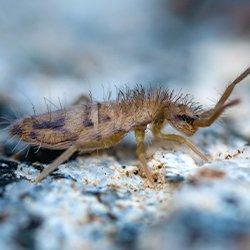Just because something is small doesn’t mean it can’t be a problem. Some pests, like tiny springtails, are nearly microscopic but they can still be huge nuisances for property owners who don’t take the proper preventative measures. Arming yourself with knowledge of their habitats and traits will help you stay ahead of a springtail infestation.
What Are Springtails?
Springtails get their name from their behavior of jumping with the spring-like furcula found on their rears, much like fleas do. While they are nearly microscopic -- only a fraction of a centimeter long in most cases -- springtails are visible to the naked eye and resemble peppery flakes with wispy legs and antennae. There are many varieties of springtail, however, and they can range from light to dark in color depending on their age and environment. In general, it’s best to turn to an expert for proper inspection if you think that a springtail infestation is starting.
The Problems Of A Springtail Infestation
Springtails are nuisance pests because they are not harmful to people or their pets and they aren’t known to cause significant property damage. They are most often found outdoors, but they are sometimes driven inside in search of moisture. While they aren’t known for causing much property damage, they can pose greater risks and nuisances than their harmless demeanor suggests:
- Soil blight: Springtails eat small particles of decomposed matter found in the dirt, which can make them helpful for soil regeneration. However, the organisms that benefit from their digestion are often fungi and harmful bacteria. This contributes to plant rot and root contamination.
- Contamination: While springtails don’t forage around your home for food, they can contaminate areas around a property. Frequently, springtails can infest pool filtration systems, utility boxes, and greenhouses.
- Unsightly: Even harmless pests can be nasty to have to look at or deal with. Save yourself and others from the creep-out factor of springtails by taking proper prevention steps.
Springtail Prevention Tips For Your Property
As with all pests, you can lessen springtail populations by reducing the factors that attract them to your property in the first place. Take these simple steps to make them less likely to encroach:
- Yard maintenance: Keeping a well-kept yard is about more than attractiveness, it’s also helpful for pest control. Raking up leaves and clearing out lawn debris will reduce environments where springtails thrive.
- Moisture control: Springtails are constantly seeking moisture, both inside and outside of structures. Proper drainage and ventilation are important, not just for soil and planters but also for areas inside where moisture builds up -- bathrooms, basements, and kitchens, to name a few.
- Soil contact: Since springtails tend to hang around in moist soil, it’s important to keep flower beds and planters away from the exterior of your home or business. This will lessen the chances that an infestation can move in from outside.
- Proven treatments: As with most common pests, only professional inspections and treatments provide the best certainty that pest populations won’t ever be a problem.
For Ultimate Protection, Turn To American Pest Solutions
Springtails may be small, but a population can quickly grow out of control and be incredibly hard to eradicate. These nuisances are so small that only a trained set of eyes knows what to look for anyway, so turn to your local experts for proper prevention and control. At American Pest Solutions, our friendly staff can inspect your property high and low for springtails, providing you with useful tips and tricks on how you can keep them out. If we spot an infestation, you can count on us to get rid of it.
For proper inspection or treatment of your property, you can count on American Pest Solutions.

